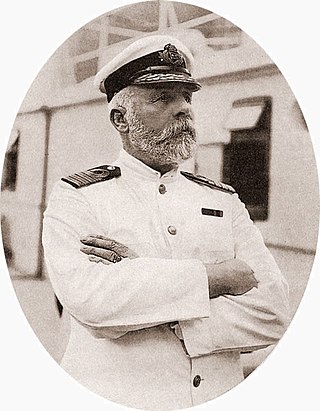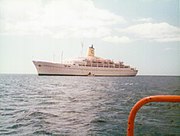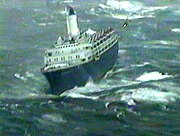
RMS Laconia was a Cunard ocean liner, built by Swan, Hunter & Wigham Richardson as a successor of the 1911–1917 Laconia. The new ship was launched on 9 April 1921, and made her maiden voyage on 25 May 1922 from Southampton to New York City. At the outbreak of the Second World War she was converted into an armed merchant cruiser, and later a troopship. She was sunk in the South Atlantic Ocean on 12 September 1942 by torpedoes. Like her predecessor, sunk during the First World War, this Laconia was also destroyed by a German submarine. Some estimates of the death toll have suggested that over 1,658 people were killed when the Laconia sank. The U-boat commander Werner Hartenstein then staged a dramatic effort to rescue the passengers and the crew of Laconia, which involved additional German U-boats and became known as the Laconia incident.

SS Yarmouth Castle, built as Evangeline, was an American steamship whose loss in a disastrous fire in 1965 prompted new laws regarding safety at sea.
Premier Cruise Lines, a subsidiary of Premier Cruises, was a cruise line that was headquartered in Cape Canaveral, Florida. From 1985 to 1993, it was licensed as the official cruise line of Walt Disney World and used the trademark "The Big Red Boat" based on the color scheme of some of its ships.

The MS al-Salam Boccaccio 98 was an Egyptian Ro/Ro passenger ferry, operated by El Salam Maritime Transport, that sank on 3 February 2006 in the Red Sea en route from Duba, Saudi Arabia, to Safaga in southern Egypt.

MS Express Samina was a French-built RoPax ferry that struck the charted Portes Islets rocks in the Bay of Parikia off the coast of Paros island in the central Aegean Sea on 26 September 2000. The accident resulted in 81 deaths and the loss of the ship. The cause of the accident was crew negligence, for which several members were found criminally liable.

Grandeur of the Seas is a Vision-class cruise ship owned and operated by Royal Caribbean International. Features include a full-service spa, six whirlpools, an outdoor jogging track and a number of bars and restaurants. It was announced on 16 October 2019 that Grandeur of the Seas will be transferred in the second quarter of 2021 to Pullmantur Cruises, in which Royal Caribbean has a 49% stake. These plans were cancelled in mid-2020. It is currently the oldest ship still operating for Royal Caribbean.
Yiannis Avranas is a Greek former sea captain who commanded the cruise ship Oceanos when she sank off the Wild Coast of the Transkei, South Africa, on Sunday 4 August 1991. He was one of the first to be rescued while most of his passengers remained onboard the sinking ship. A Greek maritime Board of Enquiry found him and his officers guilty of negligence. In 1994, his English wife Davina published a book about the sinking entitled The Oceanos Tragedy.
A sea breeze is a wind from the sea.

MS Sea Diamond was a cruise ship operated by Louis Hellenic Cruise Lines. She was built in 1984 by Valmet, Finland for Birka Line as Birka Princess. The ship ran aground near the Greek island of Santorini 5 April 2007, and sank the next day leaving two passengers missing and presumed dead.

The Battle of the Caribbean refers to a naval campaign waged during World War II that was part of the Battle of the Atlantic, from 1941 to 1945. German U-boats and Italian submarines attempted to disrupt the Allied supply of oil and other material. They sank shipping in the Caribbean Sea and the Gulf of Mexico and attacked coastal targets in the Antilles. Improved Allied anti-submarine warfare eventually drove the Axis submarines out of the Caribbean region.
MV Shelly was a 1,599 GT cargo ship that was built in Bulgaria in 1973. She sank off the Mediterranean coast of Israel in 2007 after the 10,392 GT cruise ship CS Salamis Glory rammed her and broke her in two. Two of Shelly's crew were killed.

MS Explorer or MV Explorer was a Liberian-registered cruise ship, the first vessel of that kind used specifically to sail the icy waters of the Antarctic Ocean. She was the first cruise ship to sink there, after striking an iceberg on 23 November 2007. All passengers and crew were rescued.

SuperFerry 9 was a ferry owned by the Philippines-based carrier Aboitiz Transport System Corp (ATSC) and operated by their SuperFerry division. About 9 a.m. Sunday, September 6, 2009, she sank off the south-west coast of Zamboanga Peninsula with a total of 971 passengers and crew aboard.

"The captain goes down with the ship" is a maritime tradition that a sea captain holds the ultimate responsibility for both the ship and everyone embarked on it, and in an emergency they will devote their time to save those on board or die trying. Although often connected to the sinking of RMS Titanic in 1912 and its captain, Edward Smith, the tradition precedes Titanic by several years. In most instances, captains forgo their own rapid departure of a ship in distress, and concentrate instead on saving other people. It often results in either the death or belated rescue of the captain as the last person on board.
FleetPro Passenger Ship Management was founded in 2012 as a merger of two existing passenger ship management companies and is based in Switzerland. It combined International Shipping Partners (ISP), a passenger ship management services company headquartered in Miami, Florida, United States, and River Advice of Basel, Switzerland. The majority owners became a Netherlands-based private equity fund. In January 2014 the two operations were renamed FleetPro Ocean and FleetPro River respectively.

















